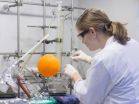(Press-News.org) Any method that leads to the production of more oil seems counter to the prevailing wisdom on climate change that says use of more greenhouse-gas-emitting fuel is detrimental. But there's one oil-recovery process that some say could be part of the climate change solution and now unites unlikely allies in industry, government and environmental groups, according to an article in Chemical & Engineering News (C&EN), the weekly news magazine of the American Chemical Society.
Jeff Johnson, a senior correspondent at C&EN, explains that a process called enhanced oil recovery (EOR), which uses carbon dioxide to force the last bits of oil out of partially depleted wells, is fueling this rare agreement. The technique is not new, but what's becoming tantalizing now is where the carbon dioxide comes from. With new advances in carbon capture, the possibility is growing that the carbon dioxide could come from power plants that otherwise would release it into the atmosphere. The environmental and economic appeal is already driving new research into carbon capture techniques. And if power plants could offset the costs of implementing these techniques by selling captured carbon dioxide to oil companies for EOR operations, it could be a win-win situation. An additional perk of enhanced oil recovery is that, according to the oil industry, about half of the carbon dioxide they use to extract oil stays underground.
But, as the article notes, the process is not entirely without flaw or opposition. The carbon dioxide that is supposed to remain tucked away can and has escaped through leaks. In one 2011 case, an inadequately capped, old well-bore released carbon dioxide for 37 days, suffocating wildlife in the area. And not all environmental groups are onboard. One is challenging a proposed project in California that they say could put the local community at risk.
INFORMATION:
The American Chemical Society is a nonprofit organization chartered by the U.S. Congress. With more than 161,000 members, ACS is the world's largest scientific society and a global leader in providing access to chemistry-related research through its multiple databases, peer-reviewed journals and scientific conferences. Its main offices are in Washington, D.C., and Columbus, Ohio.
To automatically receive news releases from the American Chemical Society, contact newsroom@acs.org.
Follow us: Twitter Facebook END
Capturing carbon to produce more oil: Climate solution or folly?
2014-04-30
ELSE PRESS RELEASES FROM THIS DATE:
Faster dental treatment with new photoactive molecule
2014-04-30
In modern dentistry, amalgam fillings have become unpopular. Instead, white composite materials are more commonly used, which at first glance can hardly be distinguished from the tooth. The majority of these composites are based on photoactive materials that harden when they are exposed to light. But as the light does not penetrate very deeply into the material, the patients often have to endure a cumbersome procedure in which the fillings are applied and hardened in several steps. The Vienna University of Technology in collaboration with the company Ivoclar Vivadent have ...
Entire star cluster thrown out of its galaxy
2014-04-30
The galaxy known as M87 has a fastball that would be the envy of any baseball pitcher. It has thrown an entire star cluster toward us at more than two million miles per hour. The newly discovered cluster, which astronomers named HVGC-1, is now on a fast journey to nowhere. Its fate: to drift through the void between the galaxies for all time.
"Astronomers have found runaway stars before, but this is the first time we've found a runaway star cluster," says Nelson Caldwell of the Harvard-Smithsonian Center for Astrophysics. Caldwell is lead author on the study, which will ...
Children's TV time is closely linked to parents' viewing habits
2014-04-30
The amount of time children spend in front of TV, phone and computer screens is closely associated with their parents' own habits, with much higher weekend viewing than during the week, a new study has found.
Researchers at the University of Bristol analysed the amount of time children aged five and six spent watching television, playing video games and using computers, tablets and smartphones – activities associated with a range of health problems, including obesity.
The study showed that 12 per cent of boys and eight per cent of girls in this age group watched more ...
Light activity every day keeps disability at bay
2014-04-30
CHICAGO --- Pushing a shopping cart or a vacuum doesn't take a lot of effort, but enough of this sort of light physical activity every day can help people with or at risk of knee arthritis avoid developing disabilities as they age, according to a new Northwestern Medicine® study.
It is known that the more time people spend in moderate or vigorous activities, the less likely they are to develop disability, but this is the first study to show that spending more time in light activities can help prevent disability, too.
"Our findings provide encouragement for adults who ...
Putting the endoparasitic plants Apodanthaceae on the map
2014-04-30
The Apodanthaceae are small parasitic plants living almost entirely inside other plants. They occur in Africa, Iran, Australia, and the New World. Bellot and Renner propose the first revision of the species relationships in the family based on combined molecular and anatomical data. They show that Apodanthaceae comprise 10 species, which are specialized to parasitize either legumes or species in the willow family.
Few plants are obligate parasites, and fewer still are endo-parasites, meaning they live entirely within their host, emerging only to flower and fruit. Naturally, ...
Coached extracurricular activities may help prevent pre-adolescent smoking and drinking
2014-04-30
Dartmouth researchers have found that tweens (preadolescents aged 10-14) who participate in a coached team sport a few times a week or more are less likely to try smoking. Their findings on the relationship between extracurricular activity and health risk behaviors are reported in "The relative roles of types of extracurricular activity on smoking and drinking initiation among tweens," which was recently published in Academic Pediatrics.
"How children spend their time matters," said lead author Anna M. Adachi-Mejia, PhD, a member of Norris Cotton Cancer Center's Cancer ...
Sell-side analysts lean towards high valuation companies for comparison
2014-04-30
Sell-side analysts lean towards high valuation companies for comparison, Rotman study shows.
Toronto – Brokerage-based analysts have a tendency to benchmark companies they are researching against others in the same category whose stock is already expensively-priced, shows a study from the University of Toronto's Rotman School of Management.
The result is that the company being researched may look undervalued and a good buy compared to the high valuation company. The finding provides some support for the idea that sell-side analysts choose "peer" companies strategically, ...
DNA repair gene provides new ideas for disease treatment
2014-04-30
A gene known to repair DNA damage in healthy cells may also provide new insights about treating a genetic disorder of the bone marrow, Caltech researchers say.
This finding was published in the May 15 print edition of the journal Cell Cycle.
In the study led by Judith Campbell, professor of chemistry and biology at Caltech, the researchers investigated the relationship between two genes—FANCD2 and DNA2—both known to play roles in fixing broken or damaged strands of DNA within a cell, called DNA repair. A defective version of the FANCD2 gene can result in the genetic ...
Watch out: Children more prone to looking but not seeing
2014-04-30
Children under 14 are more likely than adults to be 'blinded' to their surroundings when focusing on simple things, finds a new UCL study. It explains a somewhat frustrating experience familiar to many parents and carers: young children fail to notice their carer trying to get their attention because they have little capacity to spot things outside their area of focus.
The findings suggest that even something simple like looking at a loose thread on a jumper or an advert on the side of a bus might be enough to make children 'blind' to oncoming traffic and other dangers ...
Discovery of anti-appetite molecule released by fiber could help tackle obesity
2014-04-30
New research has helped unpick a long-standing mystery about how dietary fibre supresses appetite.
In a study led by Imperial College London and the Medical Research Council (MRC), an international team of researchers identified an anti-appetite molecule called acetate that is naturally released when we digest fibre in the gut. Once released, the acetate is transported to the brain where it produces a signal to tell us to stop eating.
The research, published in Nature Communications, confirms the natural benefits of increasing the amount of fibre in our diets to ...



